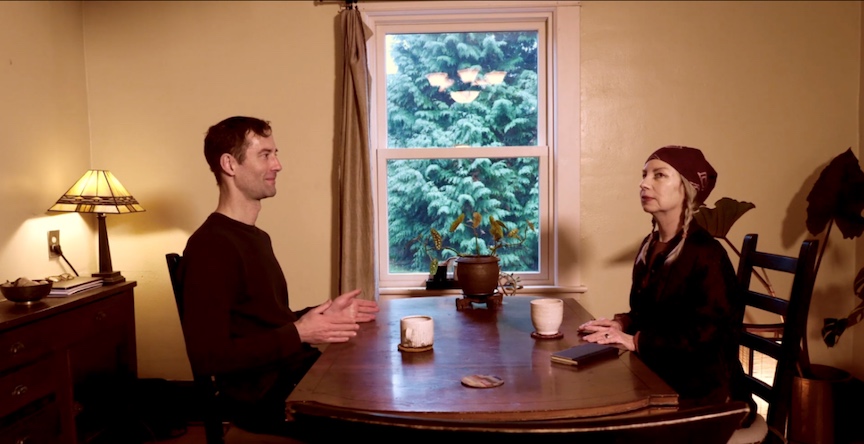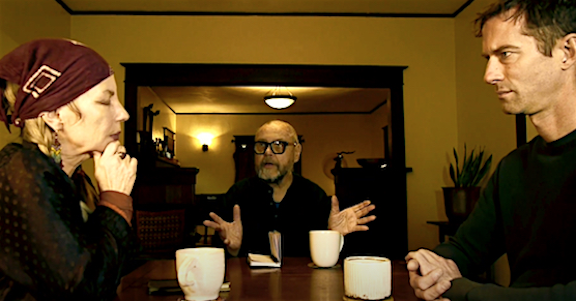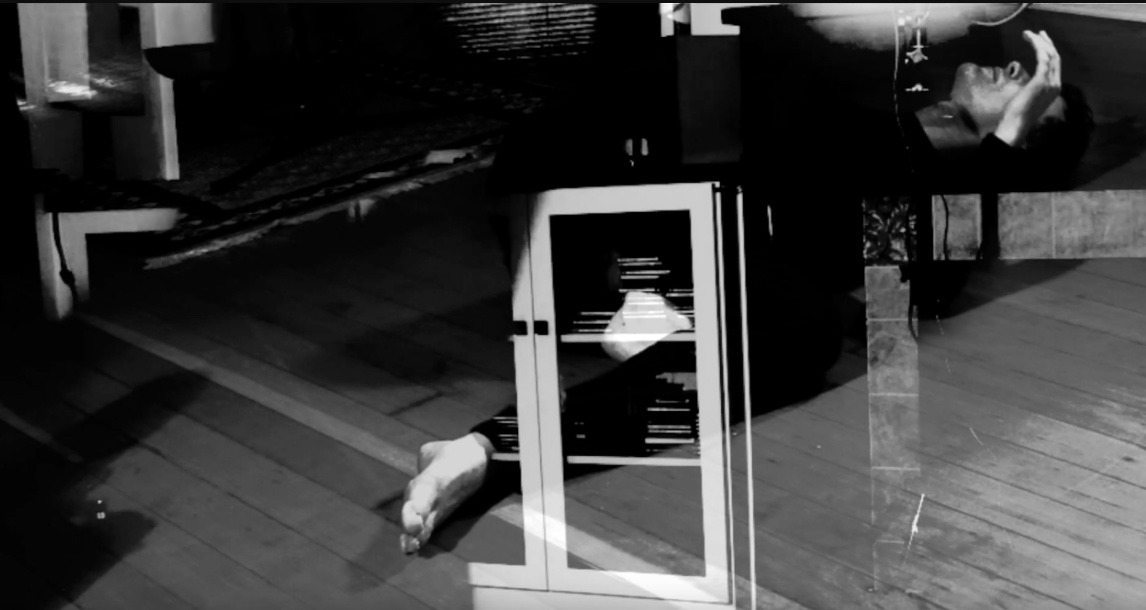"The Celebrants"
Reviewed by David Finkelstein, Lake Ivan Film Journal
The Celebrants is Antero Alli’s latest documentation of his lifelong paratheatrical research: the use of vocal and movement improvisation, normally thought of as artistic tools, as a method of spiritual and emotional exploration for its own sake (which also happens to produce some fascinating performances along the way, as a kind of artistic by-product).
The 32 minute film is a documentation of a workshop in which Alli, his partner Sylvi Alli, and collaborator Douglas Allen gather together in the Alli’s home, discussing the focus and motivation for their creative work, and then launch into an extended improvisation, with Sylvi’s wordless vocalizations, Antero’s processed guitar sounds, and Douglas’ movement improvisation. The captivating opening sequence of the film shows a domestic scene, with Douglas apparently a house-guest at the Alli’s, sleeping on the couch, while Sylvi plays Debussy on the piano and Antero goes over his notes. Sylvi and Douglas erupt into a playful, spontaneous moment of vocal and bodily improvisation in the kitchen, while preparing tea. Art-making is usually seen as a highly specialized form of work, bracketed from daily life, but here it is depicted as fully integrated with the quotidian. This holistic approach prepares us for the notion that performance techniques can encompass both art-goals and life-goals.

Sylvi Alli, Antero Alli, and Douglas Allen
Over cups of tea, Antero asks his collaborators how they enter a creative state: finding a place within themselves where creativity is able to flow forth spontaneously and easily, and he listens intently as they give their answers (both of which are well worth studying.) Antero outlines his vision of their project: he sees it as a form of group improvisation which is structured quite differently from what performing artists usually think of as “improv.” Whereas a typical “improv” one might see from a comedy group or an experimental jazz group would involve trading ideas and riffs back and forth, bouncing impulses around a group, with energy being generated primarily from “horizontal” interactions among the artists, he is proposing that each of the three of them generate the energy for the work from more “vertical” sources, that is, wellsprings of archetypal energies which are available at all times to human beings, accessible through the gateways of the body and the nervous system. (He doesn’t use exactly this terminology in the film; I’m borrowing here from his earlier films and books.) Each of the three participants allows themselves to be filled with these energies, which then spill over into actual sounds and movements.
The remainder of the film is a documentation of the improvisation itself, using somewhat grainy black and white footage, and skillfully superimposing images of dancer, singer, and guitarist. The three artists brilliantly do exactly what they said they would do: allowing themselves to be filled with energies from deep within the body, and then “offering” this energy to the other two. Sylvi’s haunting vocalizations sound animal at times, a cross between birds and wolves, veering between pitched and un-pitched passages of music, while Antero creates walls of texture, not clearly tonal, and Douglas’ movements resemble something between martial arts, and motions in which he appears to be digging, searching, drifting through space. They do indeed affect one another: Sylvi’s singing eventually lines up precisely into the meter and key of Antero’s guitar, and Douglas’ movements become rhythmically aligned as well, but it is more a case of their three energies throwing “sparks” across the space, finding mutual nodes of resonance, moments where their energies align in frequency, rather than by self-consciously tossing riffs back and forth like a ball. In certain sequences, footage of Douglas dancing from two different moments in the improv are superimposed, and this serves to reinforce the impression of the “vertical” nature of the sources for this work.
The Celebrants manages to perfectly balance it’s three centers of interest: Theory, Practice, and Life. The improvisation itself is such a compelling act of spontaneous creation, full of hauntingly beautiful moments and miraculous interconnections, that I had to both respect and celebrate the combination of artistic skill and self-knowledge that allows these three individuals to find such depth of expression and to bring it spectacularly to life. By eschewing a superficial approach to “finding connections,” these three artists are able to connect with one another at a very deep level, underneath the individual sounds and movements, in a place from which human consciousness is born. The practice embodies the theory, and both of them embody the art of living. It’s a vision of a fully integrated mode of being which is not simply a cause for celebration, it is celebration.
-David Finkelstein, Lake Ivan Film Journal
June 6, 2023
"The Celebrants" Review at Filmthreat.com


